Hidden Objects: The
Stories They Could Tell -- Characters
By
Becky Waxman
I've been exploring the world of
Interactive Hidden Object Games (IHOGs) in previous editorials, including
innovations in way Hidden Object challenges are presented, and the
incorporation of adventure game elements: more puzzles and inventory
item challenges, and the opportunity to explore in larger environments. In
case you haven't read previous editorials, IHOGs are games with Hidden
Object (HO) screens where one or more of the selected items are later used
as elements in inventory item puzzles.
Now I turn to story and characterization.
I've found IHOGs to be an excellent source for studying storytelling in
games -- partly because they are available in great variety, and partly
because they tend to be shorter than "core" games. In other words, they
provide an efficient way to experience different approaches and story
types, much like comparing or analyzing short stories rather than novels.
In this editorial, I'll focus on IHOGs with intriguing stories in which
events and puzzles are character-driven.
Character-Driven Games and Suiting Puzzles
to the Characters
Character-driven IHOGs are those where the
developer has given the main characters unique personalities, and the
gamer begins to know them well enough to be able to predict how they will
respond to various events. These games reveal character by putting the
protagonist in situations where there is conflict, mystery, and (often)
danger that is augmented or caused by non-player characters (NPCs) in the
game. These NPCs have agendas that help or hinder (or do one while
appearing to do the other). How the protagonist reacts in various
situations highlights his or her personality. Also revealing is which NPCs
the protagonist chooses to trust, and why.
One effective technique games can use to
increase knowledge of the main character is to create challenges that tap
into the protagonist's area of expertise. A lab technician's analytical
skill, or a historian's knowledge of the past, or the mental powers of a
psychic are not just central to defining the protagonist's personality --
they can also bolster puzzle/story integration. Admittedly, in the context
of a game, these skills trend more toward entertainment than heavy-duty
realism. Still, a protagonist doing puzzle-like "work" consistent with his
occupational or personal skill increases immersion and suits the story.
IHOGs that draw the protagonists' talents
or special abilities into the gameplay have more dialog and/or more cut
scenes than the typical casual game. Antagonists are often hiding in plain
sight -- a colleague or a neighbor -- and the protagonists interact with
them (sometimes several times) before discovering their villainy.
A Short Detour into the Idea of Linear
Progression in Games
The character-driven IHOGs I played also
tended to be quite linear. What do I mean by "linear"? Stories in books
and films typically begin at the beginning and unfold step-by-step. Though
some experimental books and films attempt to give a sense of nonlinearity
(often through the use of flashbacks), these are not the norm.
Like books and films, IHOGs with a linear
structure don't allow the gamer to walk around the environments, but
present one screen with its Hidden Objects, puzzles, and character
interaction, then present the next screen, and so on.
A linear progression in a game allows the
developer to exercise complete control over the story elements, including
when and how they are presented, keeping the gamer "on the right page." In
theory, a linear structure should make complex stories easier to write,
with more nuanced, plot-progressing, personality-descriptive dialog.
I expected character-driven IHOGS to
exhibit instances of witty, character-revealing dialog exchanges, but
(with a few exceptions, some of which are featured below) I was
disappointed. Why, I wondered, haven't designers taken advantage of this
subgenre to write elaborate dialogs?
I discovered that -- for a significant
percentage of gamers -- the "casual experience" means skipping the story
altogether, especially if it means that the characters engage in long
conversations. This preference has apparently discouraged IHOG designers
from writing lengthy dialogs like those seen in adventure games like
The Longest Journey or The Moment of Silence.
IHOG designers may someday write dialog
comparable to that in (for instance) the classic novel Pride and
Prejudice. But for now, they seem more concerned with keeping dialogs
from overwhelming the puzzles and HO screens.
Five Examples of Character-Driven
Interactive Hidden Object Games
Though linearity hasn't influenced dialogs
as much as I expected, linearity in character-driven IHOGS makes a twisty
plot possible in a small space. The plot is often fleshed out in brief,
graphic-novel-like cut scenes and the game contains puzzles suited to the
protagonists' specific abilities. Below I've provided descriptions of five
character-driven games. For variety, I've included IHOGs that can loosely
be classified as a thriller, a romance, a mystery with police procedural
elements, a mystery with pulp fiction elements, and a fantasy spoof.
*Note: I'm aware that
many gamers partner with their young children to play IHOGs. I've put an
asterisk in front of each game that is more appropriate for teens and up.
Unlike the games I discussed in previous IHOG editorials, most of the
games described below are not appropriate for young children -- perhaps
because deep stories delve into the darker side of human nature.
*Rhianna Ford & The Da Vinci Letter
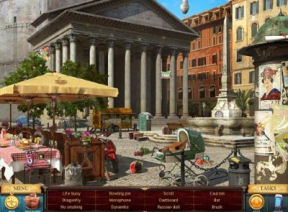
Rhianna Ford, an antiquities expert, is in
Rome examining a letter allegedly written by the hand of Leonardo da
Vinci. She is haunted by the disappearance of her husband, also in Rome,
earlier that year. She stumbles across a crime as it is committed, and
from then on she is consumed with finding out what is going on behind the
scenes, and whether her husband's disappearance is linked to a criminal
conspiracy.
This casual thriller is quite linear, and
the tight structure allows the story to unfold at a fast pace, with many
characters potentially implicated in the conspiracy. It contains frequent,
brief dialogs. Memorable character portrayals include Rhianna, who is
terrified to discover the truth about her husband, D'Agostino the cynical
Italian police inspector, and Paulo the geeky exercise addict. The gamer's
attitude toward the characters and their motives changes, reverses, or
becomes ambiguous as Rhianna's knowledge about them deepens.
Environments are photorealistic and
beautifully lit, giving the gamer many chances to see intriguing museum
artifacts, as well as glimpses of sights around Rome. Tension-inducing
music with unusual rhythms and sounds adds to the atmosphere. The only
downside -- the voiced, cartoon-like cut scenes are decidedly different
visually, making them unintentionally disruptive and distracting.
Locations are single screens and always
contain a "find" list. In addition to the HO gameplay, the game has well
integrated puzzles (some of which spring from the heroine's art history
expertise), including comparing ink and fiber samples and using an
ultraviolet light to discover hidden symbols. Adventure gamers will
recognize Rhianna Ford & The Da Vinci Letter designer Steve Ince of
Broken Sword fame.
*Tiger Eye Part 1: Curse of the Riddle Box
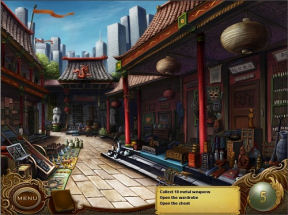
Based on a romantic story by author
Marjorie M. Liu, Tiger Eye features Dela Reese, a young woman with
as-yet-untested paranormal abilities (particularly the ability to shape
metal) and Hari, a magical being forced to serve a series of masters over
the centuries. The tale begins in modern day China, where Dela and Hari
first meet and where the evil pursuing them first attempts to take hold.
Frequent graphic-novel-like cut scenes,
fully voiced, portray the couple's adventures. I've never seen a story
quite like it in a game. It ricochets between drama, danger and lust and
snuggles up next to melodrama. (Keep a fire extinguisher handy just in
case a torrid scene sets your monitor aflame.) Themes include the effects
of magic breaking into the real world, and how oppression and cruelty
shape a person's character. The game has a cliffhanger ending. It'll be
fun to see how the story unfolds through the sequel.
Graphics are colorful and cartoon-like,
and the game is very linear. The HO searches are for multiples of items in
the same category (find 10 metal weapons, for example).
Dela's psychic abilities increase in
strength and importance as the story progresses. These powers are
introduced in game form through an untimed match three sequence, where
squares are cleared away so that a vision is gradually revealed. There are
also sequences during which Dela undergoes a form of psychic attack and
activates mind defenses -- this is represented by a neuron connection game
that starts out easy and then becomes dastardly.
Overall the puzzles in this games are
frequent and varied (though some puzzles repeat through several
iterations). Expect pattern and shape analysis, inventory challenges,
matching, jigsaws, and even a shopping challenge. I particularly enjoyed
the word puzzles, a couple of which were types I hadn't encountered
before.
*James Patterson Women's Murder Club:
Little Black Lies
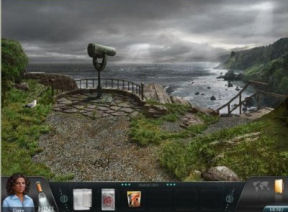
This game features the characters from
James Patterson's novels about a group of truth-seeking professionals who
form the Women's Murder Club (WMC). You alternately assume the roles of
three members of an investigatory team: Lindsay Boxer (detective), Claire
Washburn (medical examiner), and Cindy Thomas (journalist). When a friend
of Claire's is murdered, the WMC springs into action to find out how the
actions of a cult, supposedly disbanded years earlier, may be disrupting
the peace of an idyllic spot on the California coast.
Many of the game's puzzles are related to
tasks in the forensics lab when you play as Claire. A few are surprisingly
difficult, especially the skeleton assembly task. I was intrigued to see a
couple of word puzzles in addition to the traditional HO "find" lists -- a
crossword puzzle and a riddle-like travel challenge. (This game
incorporates a free strategy guide if you get stuck.)
The game's graphical style is
naturalistic, with the locations authentically portraying small town
America. The NPCs also suit the small town atmosphere -- including Beverly
Connors, the librarian who can't decide whether to be helpful or hostile,
and Sympathy Morgan, the laidback owner of the craft shop at The Crystal
Barn. Little Black Lies has brief and to-the-point dialogs,
competently voiced. A map with hotlinks to the various locations is
included.
This game is less linear than the previous
two I've described above, but some degree of linearity is enforced by
changing roles to play the various protagonists. There's also less
character growth than in the first two games -- mostly, I suspect, because
the Women's Murder Club is a long-running series, where the gamer
becomes gradually acquainted with the main characters over several games.
After the murderer is revealed in
Little Black Lies, the Epilogue takes you back in time and puts you in
the role of a character desperately trying to cover up a crime. It was a
different type of role than I've played in a casual game, disconcerting
and chilling. Jane Jensen, designer of the Gabriel Knight adventure
games, was involved with the game's design as Creative Director.
*Valerie Porter and the Scarlet Scandal
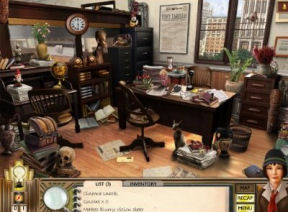
Set in the Roaring Twenties in urban
America, Valerie Porter and the Scarlet Scandal follows the
adventures of a fledgling newspaper journalist as she investigates the
murder of a film star. The game starts with the murder, goes through an
extensive flashback, and then continues with the investigation in a mostly
linear fashion.
Graphics are clear, bright, and somewhat
stylized, and jazzy music plays in the background. All the characters are
competently voiced. Valerie is making her way in a world that clearly
favors male journalists -- her boss regularly treats her like an errand
girl.
Several puzzles are related to Valerie's
writing skills, including word searches, finding the correct words for a
feature story, and spelling out headlines. The game also contains photo
adjustment, persuasion and mechanical assembly challenges. HOs are "find"
lists, sometimes with multiple similar objects, and sometimes with
descriptive phrases rather than single words. You can also click to see
silhouette shapes for the items on the list.
Valerie's competence in ferreting out
sensationalist secrets increases through the game, as does her tendency to
remove items from any room in which she is left alone. (Note to self: if a
reporter asks for an interview, hide all embarrassing personal
belongings.) Other characters tend toward the stereotypical -- the
demanding editor, the slick politician, the gruff professional boxer. (The
most memorable and non-stereotypical NPC is Valerie's mentor Terry Morgan,
who has established herself as an ace female reporter despite the odds
against her.) Stereotypes are used in a thought-provoking way here,
however, as some of the characters react unexpectedly when the story
reaches its culmination.
Magic Academy II
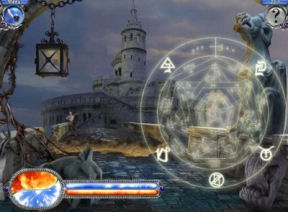
This is the tale of an ambitious young
Magic Academy graduate who is determined to work her way onto the powerful
Magician's Council. She approaches the Council at a time when it's in a
state of near chaos. Some of the members think that a traitor has
unleashed a demon into their castle fortress. Others deny that this would
even be possible. Suspicions leapfrog among the magicians, and settle on
Irene's sister, Annie, who works with foreign emissaries at the fortress.
Determined to prove her worth (and clear
her sister's name), Irene sets out to learn as much as she can about the
demon and a mysterious box that exhibits demonic traces. She works with
various aspects of magic -- runes, potions, and magical energy. Irene also
performs many tasks, often related to magic that is now out of control.
The loss of control is shown through the
game's challenges. For example, the eccentric magicians at the fortress
create illusions they can't remove (spot-the-difference challenges),
forget how to access certain rooms in the castle (inventory challenges)
and accidentally change all the insects in the castle into animals (HO
challenges). HO challenges feature item silhouettes, multiples of the same
item, and a few "find" lists. Often objects are in drawers or behind
curtains. The game also contains a full complement of puzzles, a few of
which are mildly timed. Most of the puzzles are familiar types, but others
are fresh -- the magical well, for instance, and the bouncing marble
challenge.
Graphics are naturalistic, quaint and
colorful. Pleasant orchestral music plays in the background. The story is
linear; dialogs are droll and often tongue-in-cheek. All are fully voiced.
Voiceovers are competent, though Irene sounds a tad too young and eager,
especially for a magician with so much range and talent.
Memorable NPCs include Irene's sister
Annie who looks like Queen Amidala (minus the face paint) and Alchemist
Ferrous, who can believe six impossible things before breakfast and wants
to use magic to enable them.
One downside: Magic Academy II --
developed by NevoSoft, the same developers who created Vampireville
-- contains a similar save system. If you quit mid-chapter, you start
again at the beginning of that chapter when you resume.
Conclusion
In this editorial I've discussed one
approach to "playing a story" -- the character-driven Interactive Hidden
Object Game. I've also provided a handful of examples for playing and
pondering. There are many more aspects to discuss about storytelling in
casual games but this is, at least, a start.
To recap: in character-driven IHOGs, you
as the player become acquainted with the protagonist, feel the force of
her distinct personality, see how other characters react to this person,
and are encouraged to begin to think like the protagonist. These games
tend to have complex stories that are fairly (or very) linear, frequent
interaction with NPCs, and puzzles based on the protagonist's skills or
knowledge. Linearity brings a compression of action and events so the
story packs more punch.
Look to this space to see more discussion
of stories in casual games. Coming up next: "Hidden Objects: The Stories
They Could Tell -- Quests."
**Note: some of the ideas for this article
were influenced by Writing for Video Games, a book by Steve Ince.